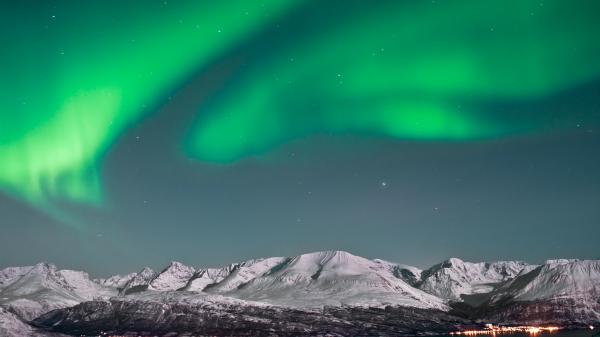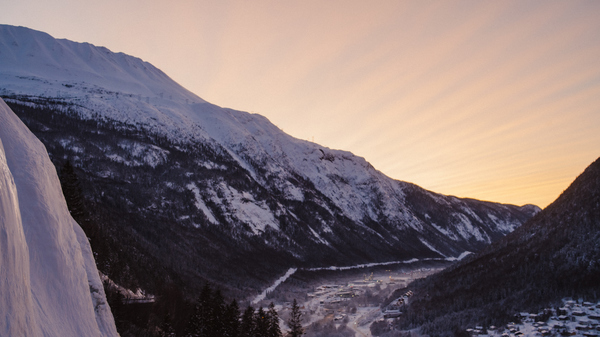What Is Polar Night?
Polar night is the opposite of midnight sun, when none of the Sun's disc is visible above the horizon at all. It only happens within the polar circles.

Arctic areas on Earth's day side do not receive any sunlight around the December solstice, resulting in polar night within the Arctic Circle.
© timeanddate.com
The opposite of polar night is midnight sun or polar day.
Polar nights occur in the polar regions during the winter months:
- Northern Hemisphere: September–March
- Southern Hemisphere: March–September
As the polar region tilts away from the Sun during the winter, even areas that are on the Earth's day side do not receive any direct sunlight as the Sun stays below the horizon.
The start of polar night at the South Pole
Northern polar night on a world map
Where Can You See a Polar Night?
Polar nights occur in many populated areas of the Northern Hemisphere. Although Norway promotes itself as the Land of the Midnight Sun, you can also see it in parts of Alaska, Canada, Greenland, Finland, Russia, and Sweden.
The only landmass far enough south in the Southern Hemisphere to have polar nights is Antarctica.
Starts Around the Equinox
At the North Pole, the polar night begins as the Sun sets around the autumnal (fall) equinox in September. It lasts for about 6 months until the Sun rises again around the vernal (spring) equinox in March when 6 months of Polar Day / Midnight Sun begin.

Northern lights (aurora borealis), stars, and the Moon light up the polar night in northern Norway.
©bigstockphoto.com/sdimitrov
As the Sun gradually dips further below the horizon at the North Pole after the September equinox, the area experiencing polar night gradually grows southwards until it encompasses nearly all of the Arctic Circle around the December solstice.
Changes After Solstice
After the winter solstice in December, the polar night area recedes again, moving north towards the North Pole. Around the spring equinox in March, the Sun finally rises again at the North Pole, ringing in a Polar Day lasting about 6 months.
Solstices & equinoxs worldwide
Opposite in the Southern Hemisphere
In the Southern Hemisphere, it's opposite. There, areas within the Antarctic Circle experience Polar Days when the Northern Hemisphere has polar nights.
Why Not on the Polar Circles?
In locations just inside the Arctic Circle, there may be no polar night around the December solstice. For example, in Gällivare, Sweden there is never a 24-hour night, even though the city is about 60 miles (100 km) north of the Arctic Circle.
There are several reasons why the polar night region does not quite extend to the polar circle. Firstly, while sunrise and sunset are defined based on the visibility of the Sun's upper edge, the polar circle is defined as the latitude where the Sun's center, not the upper edge, touches the horizon.
The other reason is refraction – the fact that light bends when it hits the Earth's atmosphere. Refraction makes the Sun visible above the horizon several minutes before it actually gets there, so a small portion of the Sun's disk may be seen even in areas just within the polar night region.
Even in regions well within the polar circles, polar nights are not necessarily completely dark because the Sun might be just below the horizon around noon, producing twilight.

The Norwegian village of Rjukan doesn’t get much direct sunlight during the winter, so authorities installed a set of mirrors on the mountainside.
©iStockphoto.com/MatsBehring
Bringing Light to Dark Places
The long hours of darkness in polar areas can have an impact on the people who live there. One community in Norway has taken an innovative approach to lifting the gloom and bringing more sunlight into their remote town.
Rjukan, some three hours west of Oslo, is nestled deep in a valley framed by tall peaks and gets almost no direct sunlight in the winter months. So local authorities invested in a novel idea to help the Sun-starved residents: installing large mirrors on the mountainside 450 meters above the town.
The array of three glass mirrors shifts to follow the movement of the Sun and reflects light into Rjukan´s main square. Residents can now enjoy soaking up about 85 percent of the existing sunlight in the square during the day. The experiment has proven popular with locals, who frequently gather in the artificially-created patch of sunlight to warm themselves through the winter.